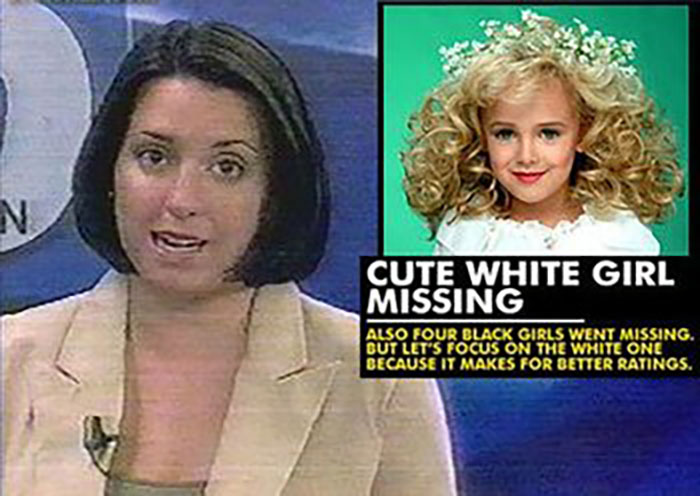I write often about crime and true crime, even though I have absolutely no connection to the law enforcement community in any way. I’ve had some success with theories and shares of different articles, which is cool — although admittedly a good deal of my close friends look at those posts and think “Whoa, that’s a bit weird.” (This weekend I was at a wedding and, at the after-party, was introduced to two people ‘fascinated by the same things as you,’ which ended up being true crime. Odd.)
Sometimes I share the missing person stuff on Facebook and other channels, although I tend not to — because of the close friend context I mentioned above — and instead, I’ll let the traffic on those posts grow through organic search. (They often do, because other people are as weird as I am.) When I do share the missing person content on Facebook, though, often I’ll get some comments like “You love a missing white girl caper!” or the like. Indeed, I do — and indeed, so does much of America. Missing white woman syndrome (or missing white girl syndrome) has its own Wikipedia.
Basically, it’s the idea that — and sociologists will back this up — we tend to over-focus on cases involving white, younger, upper-middle-class women. Most of the episodes of core crime shows have foci here: Casey Anthony, Tara Grinstead, Jennifer Kesse, Lauren Spierer, Natalee Holloway, etc. Hannah Graham and Morgan Harrington fit into that same category.
I personally have always thought this was a real thing — I used to have a podcast (I want to turn this blog into a partial podcast, but I’m lacking motivation at this exact moment) and I once interviewed Elizabeth Fischer, one of the main producers of Disappeared. She basically admitted as much: tons of families come to shows like Disappeared to get more attention on their loved one’s case, and often the shows go for the Holly Bobo and Alice Gross cases of the world.
Here’s some data from the Wall Street Journal about missing persons in the United States. The good news is this: there were 627,911 missing person reports in 2013. As of September 1, 2014, that number was 83,685 — meaning 2014 should end on a much-lower note. 1997 was the peak of this tracking, at about 1 million missing persons cases. But then there’s this graph:
In the 18+ category, there’s a big discrepancy between “percent of population” and “percent of missing persons” between black and white missing persons, as you can see. (The ratio is fairly huge for under 18 in both cases.)
Here’s some context on why that discrepancy may exist:
“Minorities are disappearing for the same reasons as other people—mental illness, sex trafficking, parental and stranger abductions, domestic violence—however, as the data show, it’s at a disproportionate rate,” said Natalie Wilson, cofounder of Black and Missing Foundation, an organization dedicated to highlighting this issue. ”As an organization, we’re trying to understand why we’re disappearing at such an alarming rate.”
What’s worse, Ms. Wilson believes the number of missing blacks is underreported.
“What we’re finding with missing people of color is that reports are not always taken or being made by the family,” she said. “We’re noticing that individuals may not know what to do or how to file a police report or, if they did, one wasn’t taken because the police say they’re [the black victim is] an adult and can walk away at any time.”
This could correlate with the idea that black communities / minority communities in general have a less-than-stellar relationship with the police, and thus if someone goes missing, they may not (a) want or (b) know the protocol involved in reporting and filing the correct paperwork. That’s one possibility.
The other possibility is simply that missing white woman syndrome does exist — that producers/leaders of media tend to be white, and react more viscerally to “their own” (other white people) going missing, as well as the idea that most people that watch cable news shows are probably white, and they’d relate more directly to the idea of a missing white person too. Women are supposed to be the fairer sex, and the “protected” sex (generalizations, but still), and men probably go missing a bit less than women — and when a woman goes missing, the narrative involved is usually going to be more suited to TV coverage.
I’d also argue that it’s nearly impossible for a conventionally-not-attractive-woman to be profiled on a true crime show. I’ve seen some distance from this concept in recent years, but not a ton. Most of the women I listed above, and most of the notable cases you probably know about, are all conventionally-beautiful women.
I’d argue missing white woman syndrome does exist, the more I think about it. Would you?

